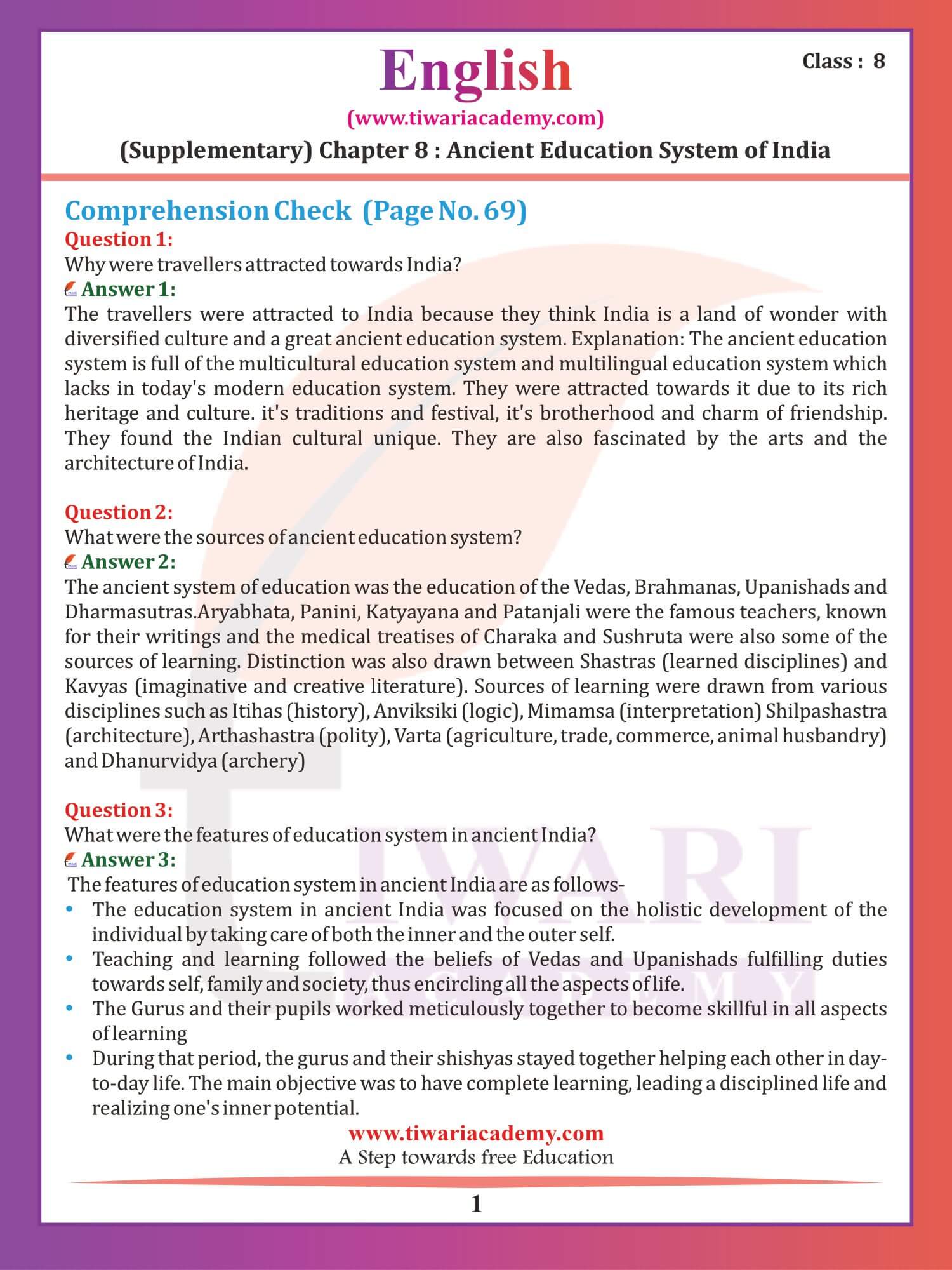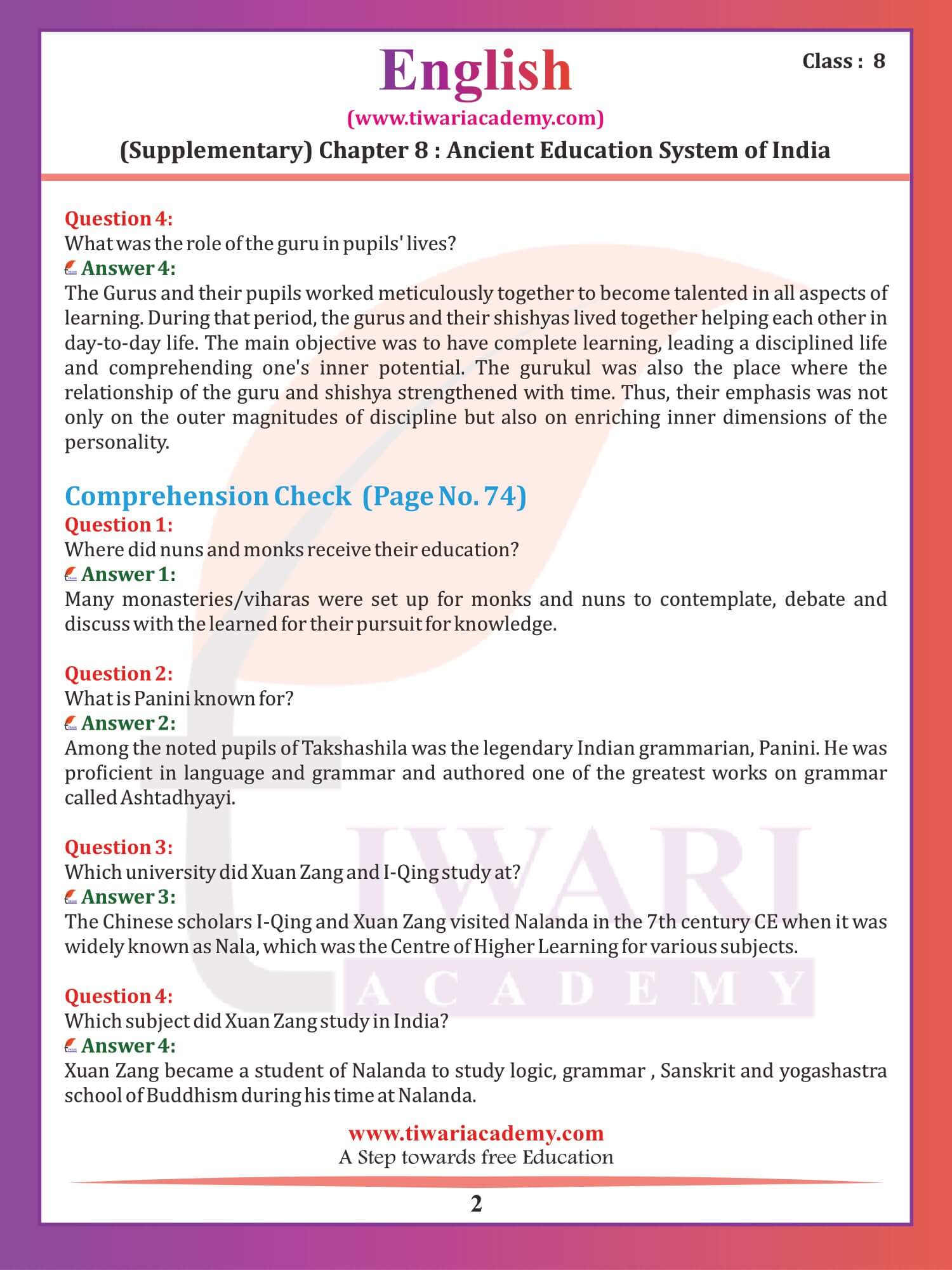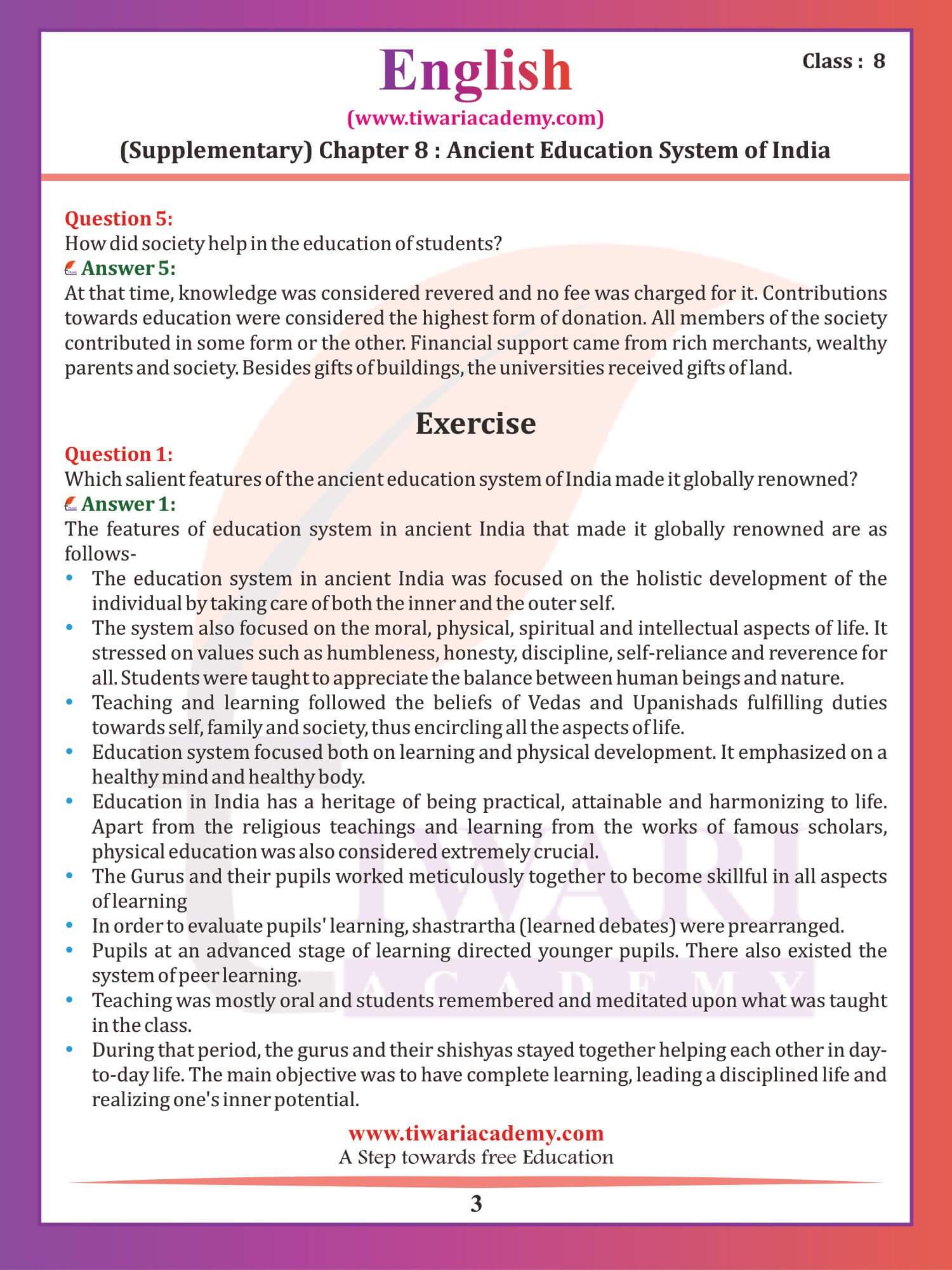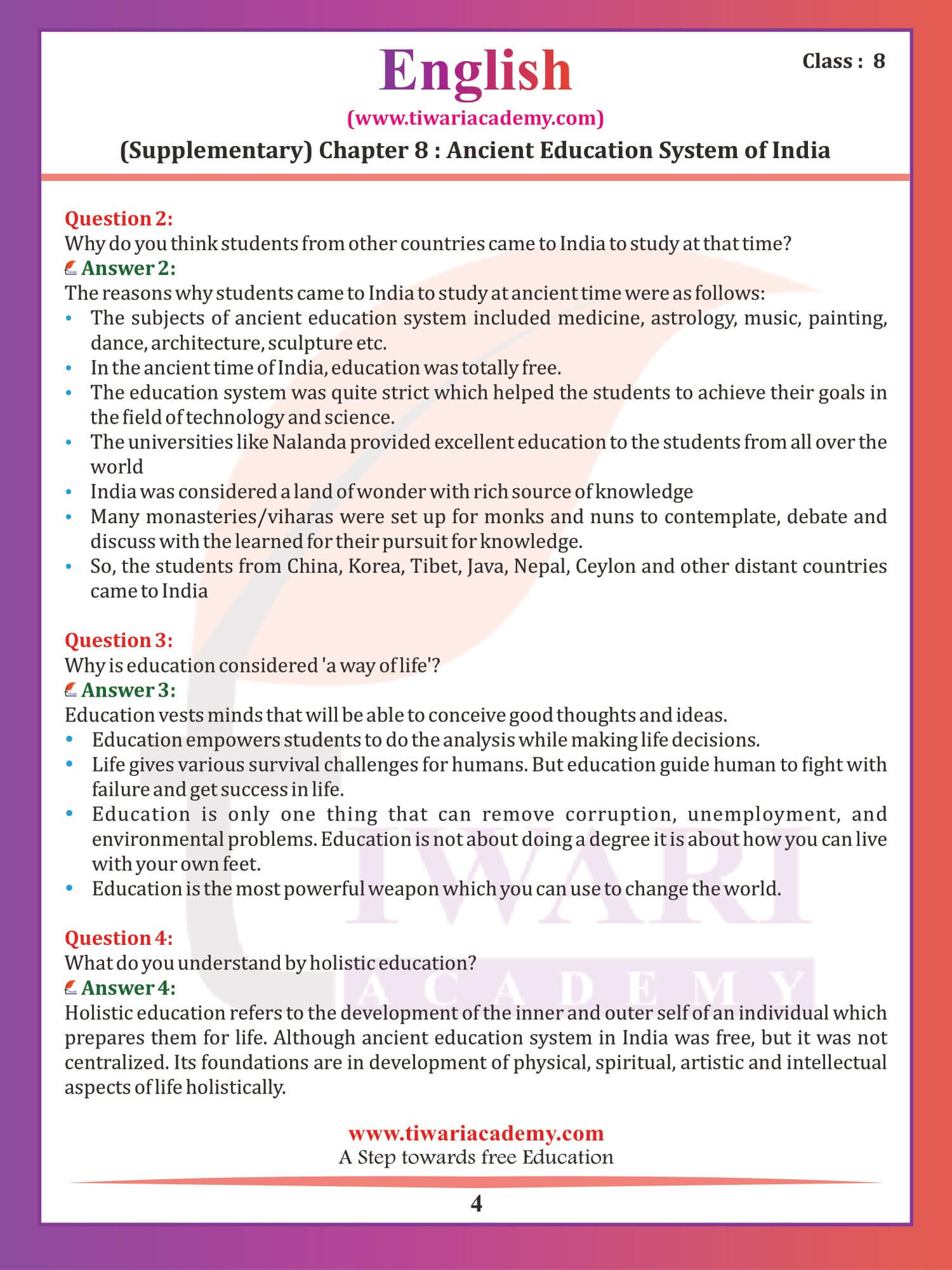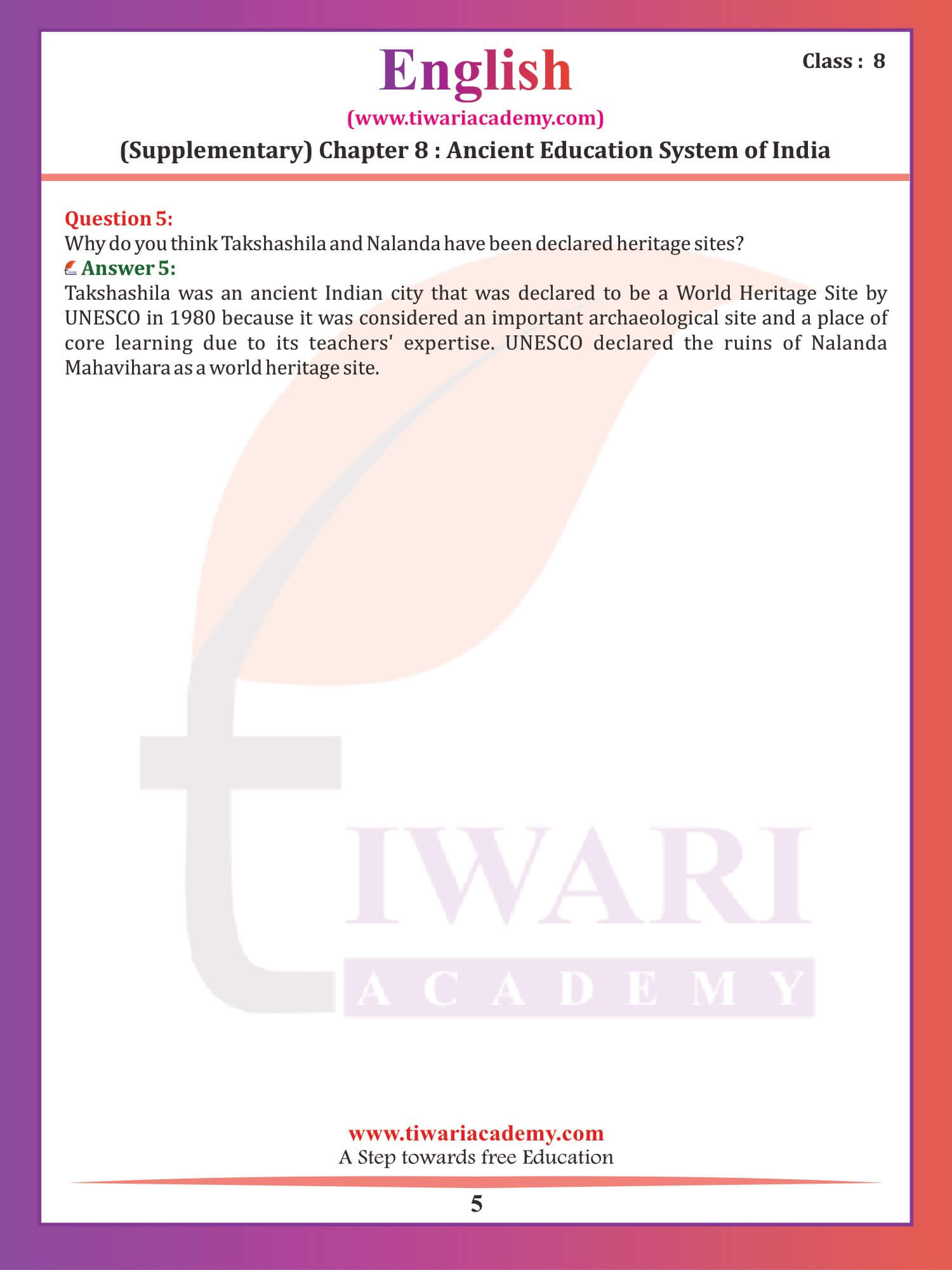NCERT Solutions for Class 8 English Supplementary Chapter 8 Ancient Education System of India updated for academic session 2025-26. The question answers and English to Hindi translation of chapter 8 in It So Happened is modified and revised as per the new NCERT textbooks issued for 2025-26 exams.
Class 8 English Supplementary Chapter 8 Ancient Education System of India Answers
Why were travellers attracted towards India?
The travellers were attracted to India because they think India is a land of wonder with diversified culture and a great ancient education system. Explanation: The ancient education system is full of the multicultural education system and multilingual education system which lacks in today’s modern education system. They were attracted towards it due to its rich heritage and culture. it’s traditions and festival, it’s brotherhood and charm of friendship. They found the Indian cultural unique. They are also fascinated by the arts and the architecture of India.
Comprehension Check
Question:
Where did nuns and monks receive their education?
Answer:
Many monasteries/viharas were set up for monks and nuns to contemplate, debate and discuss with the learned for their pursuit for knowledge.
Question:
What is Panini known for?
Answer:
Among the noted pupils of Takshashila was the legendary Indian grammarian, Panini. He was proficient in language and grammar and authored one of the greatest works on grammar called Ashtadhyayi.
Why do you think students from other countries came to India to study at that time?
The reasons why students came to India to study at ancient time were as follows:
The subjects of ancient education system included medicine, astrology, music, painting, dance, architecture, sculpture etc.
In the ancient time of India, education was totally free.
The education system was quite strict which helped the students to achieve their goals in the field of technology and science.
The universities like Nalanda provided excellent education to the students from all over the world
India was considered a land of wonder with rich source of knowledge
Many monasteries/viharas were set up for monks and nuns to contemplate, debate and discuss with the learned for their pursuit for knowledge.
So, the students from China, Korea, Tibet, Java, Nepal, Ceylon and other distant countries came to India
What were the sources of ancient education system?
The ancient system of education was the education of the Vedas, Brahmanas, Upanishads and Dharmasutras.Aryabhata, Panini, Katyayana and Patanjali were the famous teachers, known for their writings and the medical treatises of Charaka and Sushruta were also some of the sources of learning. Distinction was also drawn between Shastras (learned disciplines) and Kavyas (imaginative and creative literature). Sources of learning were drawn from various disciplines such as Itihas (history), Anviksiki (logic), Mimamsa (interpretation) Shilpashastra (architecture), Arthashastra (polity), Varta (agriculture, trade, commerce, animal husbandry) and Dhanurvidya (archery).
Question:
Which university did Xuan Zang and I-Qing study at?
Answer:
The Chinese scholars I-Qing and Xuan Zang visited Nalanda in the 7th century CE when it was widely known as Nala, which was the Centre of Higher Learning for various subjects.
How did society help in the education of students?
At that time, knowledge was considered revered and no fee was charged for it. Contributions towards education were considered the highest form of donation. All members of the society contributed in some form or the other. Financial support came from rich merchants, wealthy parents and society. Besides gifts of buildings, the universities received gifts of land.
What were the features of education system in ancient India?
The features of education system in ancient India are as follows-
The education system in ancient India was focused on the holistic development of the individual by taking care of both the inner and the outer self.
Teaching and learning followed the beliefs of Vedas and Upanishads fulfilling duties towards self, family and society, thus encircling all the aspects of life.
The Gurus and their pupils worked meticulously together to become skillful in all aspects of learning
During that period, the gurus and their shishyas stayed together helping each other in day-to-day life. The main objective was to have complete learning, leading a disciplined life and realizing one’s inner potential.
Question:
Which subject did Xuan Zang study in India?
Answer:
Xuan Zang became a student of Nalanda to study logic, grammar , Sanskrit and yogashastra school of Buddhism during his time at Nalanda.
Which salient features of the ancient education system of India made it globally renowned?
The features of education system in ancient India that made it globally renowned are as follows-
The education system in ancient India was focused on the holistic development of the individual by taking care of both the inner and the outer self.
The system also focused on the moral, physical, spiritual and intellectual aspects of life. It stressed on values such as humbleness, honesty, discipline, self-reliance and reverence for all. Students were taught to appreciate the balance between human beings and nature.
Teaching and learning followed the beliefs of Vedas and Upanishads fulfilling duties towards self, family and society, thus encircling all the aspects of life.
Education system focused both on learning and physical development. It emphasized on a healthy mind and healthy body.
Education in India has a heritage of being practical, attainable and harmonizing to life. Apart from the religious teachings and learning from the works of famous scholars, physical education was also considered extremely crucial.
The Gurus and their pupils worked meticulously together to become skillful in all aspects of learning
In order to evaluate pupils’ learning, shastrartha (learned debates) were prearranged.
Pupils at an advanced stage of learning directed younger pupils. There also existed the system of peer learning.
Teaching was mostly oral and students remembered and meditated upon what was taught in the class.
During that period, the gurus and their shishyas stayed together helping each other in day-to-day life. The main objective was to have complete learning, leading a disciplined life and realizing one’s inner potential.
Why is education considered ‘a way of life’?
Education vests minds that will be able to conceive good thoughts and ideas.
Education empowers students to do the analysis while making life decisions.
Life gives various survival challenges for humans. But education guide human to fight with failure and get success in life.
Education is only one thing that can remove corruption, unemployment, and environmental problems. Education is not about doing a degree it is about how you can live with your own feet.
Education is the most powerful weapon which you can use to change the world.
What was the role of the guru in pupils’ lives?
The Gurus and their pupils worked meticulously together to become talented in all aspects of learning. During that period, the gurus and their shishyas lived together helping each other in day-to-day life. The main objective was to have complete learning, leading a disciplined life and comprehending one’s inner potential. The gurukul was also the place where the relationship of the guru and shishya strengthened with time. Thus, their emphasis was not only on the outer magnitudes of discipline but also on enriching inner dimensions of the personality.
What do you understand by holistic education?
Holistic education refers to the development of the inner and outer self of an individual which prepares them for life. Although ancient education system in India was free, but it was not centralized. Its foundations are in development of physical, spiritual, artistic and intellectual aspects of life holistically.
Why do you think Takshashila and Nalanda have been declared heritage sites?
Takshashila was an ancient Indian city that was declared to be a World Heritage Site by UNESCO in 1980 because it was considered an important archaeological site and a place of core learning due to its teachers’ expertise. UNESCO declared the ruins of Nalanda Mahavihara as a world heritage site.
